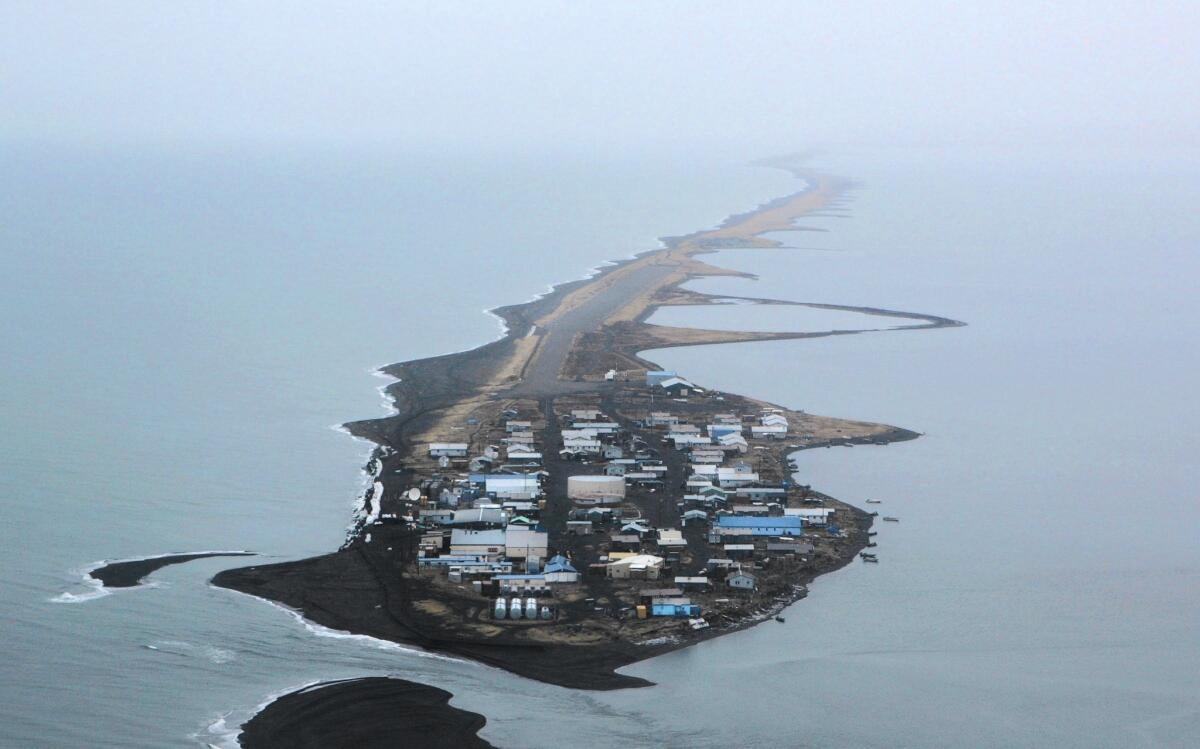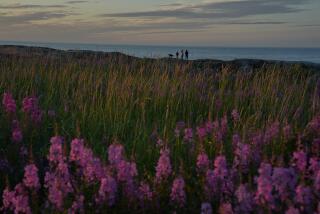This is climate change: Alaskan villagers struggle as island is chewed up by the sea

Reporting from KIVALINA, Alaska — This is what climate change looks like, up close and personal.
In this town of 403 residents 83 miles above the Arctic Circle, beaches are disappearing, ice is melting, temperatures are rising, and the barrier reef Kivalina calls home gets smaller and smaller with every storm.
There is no space left to build homes for the living. The dead are now flown to the mainland so the ocean won’t encroach upon their graves. Most here agree that the town should be relocated; where, when and who will pay for it are the big questions. The Army Corps of Engineers figures Kivalina will be underwater in the next decade or so.
See the most-read stories this hour >>
Because the town’s days on the edge of the Chukchi Sea are numbered, no money has been invested to improve residents’ lives. Eighty percent of the homes do not have toilets. Most rely on homemade honey buckets — a receptacle lined with a garbage bag topped by a toilet seat.
Residents haul water from tanks in the middle of town, 25 cents for five gallons. The school is overcrowded. Still, the unpaved streets here ring with the laughter of children, the buzz of all-terrain vehicles, the whoosh of the wind.
Earlier this summer, White House advance staff cased the slender, apostrophe-shaped island to see whether President Obama could get here during his visit to the Arctic this week — the first by a sitting White House occupant. At the very least, he is scheduled to visit Kotzebue, less than 100 miles away, the heart of Alaska’s Northwest Arctic Borough.
Obama has high hopes for addressing climate change during his remaining time in office. The Alaska trip is part of a global warming tour. In Washington he will talk environmental issues with Pope Francis in late September, and in Paris he will attend the United Nations Climate Change Conference in November.
The Alaska trip is part of an effort to “speak openly, honestly and frequently about how climate change is already affecting the lives of Americans and the strength and health of our economy,” senior White House advisor Brian Deese said.
NEWSLETTER: Get the day’s top headlines from Times Editor Davan Maharaj >>
Alaskans, Obama said Saturday in his weekly address, are already living with climate change’s effects: “More frequent and extensive wildfires. Bigger storm surges as sea ice melts faster. Some of the swiftest shoreline erosion in the world — in some places, more than 3 feet a year.
“Alaska’s glaciers are melting faster too,” he said, “threatening tourism and adding to rising seas. And if we do nothing, Alaskan temperatures are projected to rise between six and 12 degrees by the end of the century, changing all sorts of industries forever.”
Although Obama views this state as the U.S. poster child for climate change, some Alaskans beg to differ. They are glad the president agreed to allow limited offshore oil exploration. They want more access to the vast state’s natural resources. And they are wary of a leader who views their home as a global warming disaster area.
Gov. Bill Walker, who will meet with Obama during his visit to the Last Frontier, said he wants the president to support a natural gas pipeline and allow drilling in the Arctic National Wildlife Refuge.
But most of all, the independent governor said in a news conference Tuesday, he doesn’t want the Lower 48 to achieve its environmental goals on the backs of Alaskans by barring access to natural resources.
“We probably have the smallest footprint per capita in the nation, if not the world, on impacting climate change,” Walker said. “We have some impacts, there’s no question, but ... I’m going to talk a lot about the economic climate change that we’re experiencing today. That’s really what my focus is going to be on with the president.”
Shelby Adams has a different message for Obama. That is, if she gets to talk to him when he travels more than 3,600 miles from the Beltway to see the Arctic with his own eyes. Shelby, who just turned 13, has lived in Kivalina her entire life, and she loves her island home dearly.
“It’s where I grew up, where everybody I know is,” she said five days before Obama was scheduled to land in Kotzebue. “We need to relocate because the ocean is slowly eating away our island.”
Shelby was in fourth grade when much of Kivalina was forced to evacuate during a fierce storm in 2011. She and her family were on one of the few planes that made it to the mainland before flying conditions became too dangerous. Everyone else sheltered in the school, the highest point on the nearly flat island.
“We had people sleeping in all the classrooms and the gym,” said Emma Knowles, who was Shelby’s teacher at McQueen School that year. “Someone had gotten a caribou the day before, so we made a huge pot of caribou stew.... The school didn’t even budge. As dilapidated as it looks, it survived.”
Kivalina is no stranger to harsh weather, and erosion worries have dogged the 27-acre town almost since its inception in 1905. In the 21st century, however, warming temperatures and the perilous changes that cascade from them have stripped the island of its major source of protection: ice.
Normally each fall, ice begins hugging the Kivalina shoreline around the end of October and stays until the end of June. Even during fierce storms, ice keeps the raging ocean away. But climate change has caused the ice to appear later and melt earlier, leaving the barrier island more vulnerable to storm surges.
Thinner ice also makes it harder for the Inupiat to go whaling. Normally, crews will build camps at the edge of the so-called shore-fast ice and hunt bowhead and beluga whales as they swim north in spring.
“If the shore-fast ice is thin and weak, it’s not safe to make a camp,” said Timothy Schuerch, president of the Maniilaq Assn., a tribally operated health services organization with clinics in Kivalina and the other borough villages. “Whaling crews have drifted out to sea.”
The Inupiat who live in Kivalina get most of their food from the land and sea around them. The increasingly warm weather means an abundance of cloudberries and low-bush blackberries, said Millie Hawley, Kivalina tribal president, but it also threatens many of the food staples on which Alaska natives here depend.
“With the caribou, usually it’s like clockwork,” Hawley said. “Every June, we’d hunt. We haven’t done that in years. It’s unpredictable. We don’t know when we’ll see them.”
Kivalina residents hang the caribou’s hindquarters outside of their homes to age. The frozen meat is eaten raw, dipped in seal oil, which is also harvested in June. Trout is eaten the same way. The Inupiat also depend on seal for meat.
“Usually we get 80 to 100 seals for the whole community,” Hawley said. “This year, we were looking to get eight. The community now has to go without dried meat and oil.”
When their traditional foods become scarce, island residents must depend on the Kivalina Native Store, the only one in town. Kivalina is closer to Russia than it is to Anchorage, and nearly all supplies are shipped here by air. Which accounts for astronomical prices:
A quart of shelf-stable whole milk runs $4.19. A can of Campbell’s tomato soup is $2.95. A 5-pound bag of unbleached, all-purpose flour is $8.75. A 25.5-ounce bottle of Bertolli extra virgin olive oil is $23.79.
The store is Kivalina’s pride and joy, the newest building in this wind-battered town. The old store burned down in December. Its replacement opened in July. It is big, clean, warm and well-stocked. And it stands out in a town of peeling paint and crowded, threatened structures, most on short stilts to protect from flooding.
The school, attended by 154 students from pre-kindergarten through high school, is so jammed that every available space is used for storage. Hallways, stairwells and classrooms are lined with books and supplies. A working washing machine stands at the end of one hall.
The main drags, Bering and Channel streets, are unpaved, their gravel surfaces deeply rutted from the rain and the ATVs that residents use to get around in summer.
Small houses crowd together; each is home to extended families, some of up to 17 or so. At least two houses, Hawley said, are in imminent danger of tumbling into the water. The cemetery lines Kivalina’s slender runway, its crosses visible on takeoff and landing.
Because of erosion, there is almost no room to build, Hawley said, so “we break every state and federal regulation. The airport is supposed to be a mile or a mile and a half from the dump. It’s 500 feet away.”
The fuel tanks that run the power plant were in danger of falling into the Chukchi Sea, so the town moved them to higher, safer ground. Fifty feet away is a small cluster of housing for teachers, which cozies up right next to the school.
When Hawley is asked why her people don’t move — somewhere, anywhere to be safe — she is polite but firm. The land and the water make the Inupiat who they are. If they moved to Kotzebue, they would be visitors.
Moving to Anchorage or Fairbanks, she said, “would be like asking us not to be a people any more.”
So what does she want to tell the leader of the free world when she greets him next week — in Kotzebue, if not Kivalina?
“We are American citizens,” she said, fast and fierce. “We have as much right as all of America to have access to the resources Washington provides. ... If you are going to provide millions of dollars to stop hunger in Africa, my people are hungry. Stop hunger here.”
Twitter: @marialaganga
Times staff writer Michael A. Memoli in Washington contributed to this report.
Hoy: Léa esta historia en español
ALSO:
Obama to rename Mt. McKinley as Denali
Taxpayers have never paid more for public worker pensions, but it’s still not enough
Kentucky clerk who opposes same-sex marriage turns to Supreme Court for help
More to Read
Sign up for Essential California
The most important California stories and recommendations in your inbox every morning.
You may occasionally receive promotional content from the Los Angeles Times.











